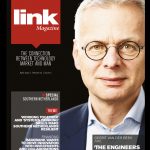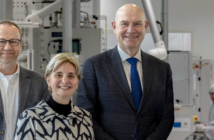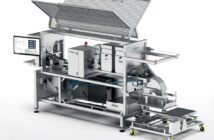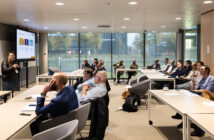In a multinational corporation with numerous locations around the world, it is a challenge to make sure a problem that arises in one place is shared with colleagues elsewhere, along with the solution found for it.At sliding roof manufacturer Inalfa Roof Systems, they have found a structured solution: the LLMS. The roll-out is now underway and has saved €1.2 million in costs in Europe alone.
Saving millions by only inventing the wheel once
Setting up the LLMS (Lessons Learned Management System) only took six months and cost €20,000. The developer and driving force behind it, Feri Mojtaba Hajmoosaei, proudly points to the screen on the wall of the room where we are talking to him, Maarten Martens, senior director business excellence and Egbert Boersma, senior director operational excellence. The dashboard which is part of the cloud-based system is visible. It shows that since the start of the roll-out of the LLMS across the European locations in March last year, 229 problems have been solved by the production departments, with 369 currently being tackled. The cost savings from the problems solved are estimated by those directly involved at €1.2 million, while the costs that will be incurred if the outstanding problems are not solved are put at €2.3 million. In short, the work of business IT project manager Mojtaba is of demonstrable value.

LLMS (Lessons Learned Management System)
Wheel already invented
The LLMS application which he developed and built is an answer to a number of major ‘challenges’ faced by the manufacturer of car sliding roofs. An inventory revealed that the same problems were arising at different locations within the global conglomerate – encompassing every stage of the life cycle of a sunroof model, from design and engineering to the point at which it is installed in thousands of cars around the world. Problems of the latter type in particular cost a lot of money. And this despite the fact that those problems could often have been solved more quickly or even prevented if the engineers or production people involved had been aware that an identical or similar problem had occurred before. The proverbial wheel had already been invented to solve it. “The fact that employees were unaware of one another was not just an issue between our people in China and those in Europe or the US. In some cases, the engineers on the second floor were unaware of solutions which the operations employees had already introduced one floor up”, Mojtaba explains.
No system in place
There was no proper system in place to prevent this kind of duplication. There was a kind of PowerPoint application, but it didn’t support the user in asking more questions to establish all the characteristics of the problem. As a result, if they were identified at all, problems were frequently described in an unclear and incomplete manner. If corporate management then had to make investment decisions aimed at solving the problem, often not all the necessary information would be available. There was also no unambiguous way of developing a solution and it was not specified which employee should perform which role. So Mojtaba was given room to build a properly functioning system.
Structured record-keeping
The LLMS enables the employee now to record a problem she detects in a structured way, using the 5W2H problem analysis tool, by answering seven questions: Who, What, When, Where, Why, How and How much? “Suppose that when testing a new sunroof model, an employee notices that the control mechanism of the roof panel is malfunctioning. Using key words such as ‘rollo’ and ‘derailing’, she can then determine whether a similar problem has occurred before and, if so, how it was resolved. If a solution already exists, she can use that information to tackle her problem. If the problem has not occurred before, she describes it using the five Ws and two Hs and estimates the cost if it remains unsolved.” Because every employee worldwide takes a course in ‘sliding-roof English’ immediately after being hired, she is able to submit that written report, according to Mojtaba.
Lesson life cycle
A local reviewer then assesses whether the investment needed to solve the problem can be recouped. If so, the resolvephase begins. An 8D project team, consisting of an 8D leader and 8D performers, get to work to establish the root cause and find a solution. This is then assessed by a global reviewer to see whether it is good enough to be implemented worldwide as a lesson learned. If so, it is recorded – sustain – in an upgraded design. Finally, every person concerned must be informed about the solution and trained in its application. The company has set up its own Inalfa Academy specifically for this purpose.
To clarify: engineering and production problems are not necessarily solved by Inalfa’s engineers or operations people. If the root cause leads to a supplier, that supplier also has to work on a solution. And the LLMS also structures the solutions and lessons learned from non-technical problems worldwide: so HR and Finance can also use the system.
Changing behaviour
Developing and building IT systems to make processes more flexible usually represents no more than ten percent of the effort needed to make them successful. That is no different in the case of the LLMS, says Egbert Boersma: “Ninety percent of the energy goes into changing people’s behaviour so that they detect errors and record them in the system. Fortunately, at this company, the operators on the factory floor at every location on every continent are very aware of their targets. If a problem requires a lot of rework, the operator will not go home until she has met the production targets and the customer has been served on time. So that drive to solve problems also comes from the factory floor.”
Push and pull
“But also from the top”, adds Martens: “Like the entire automotive industry, this company is currently experiencing testing times economically. In order to economise, the travel policy was recently amended. But when the implementation of LLMS required training employees in China, the management made an exception for the trainers. And if the management sees on its dashboards that the waste stream or the amount of rework at a particular site is increasing, they use their influence and finances to make sure LLMS is used to identify the cause and develop and implement a structured solution. The successful roll-out of LLMS is a matter of bottom-up and top-down, of push and pull.”
Faster in China
The roll-out is going according to plan, says Mojtaba. It began in March last year at the European locations, quickly resulting in a significant number of problems being identified and solved. But even in China, where the roll-out only began in November, 28 problem suggestions have already been made. “Yes, you’d expect that in that Asian culture, detecting problems – and therefore acknowledging mistakes – would make implementation more difficult, but actually I think it will now go faster there than here.” “Dutch people”, adds Martens with a knowing glance, “ask a lot more questions before adopting a new system.”
Fewer problems?
Looking further ahead, Mojtaba expects the number of problems identified to fall over time. After all, every solution means one fewer problem. And thanks to the cloud-based LLMS, that solution will be applied throughout the global conglomerate. Egbert Boersma is not so sure: “Employees will become more critical. Once the big problems have been solved, there will be room for the nagging details.”
In any case, customers are happy. “We presented the LLMS to BMW and they were so impressed that we no longer have to record problems and solutions in their portal. They consider recording them in the LLMS to be sufficient”, says a proud Feri Mojtaba Hajmoosaei.

THEME: ‘WORKING TOGETHER’ AND ‘SYSTEMS THINKING’ SKILLS MAKE THE SOUTHERN NETHERLANDS RESILIENT. Read Link magazine digitally
Perfect storm
For Inalfa Roof Systems, the cost savings thanks to LLMS are particularly opportune. Because the firm, which supplies sliding roofs to the automotive industry, is facing something of a perfect storm. While the demand for cars – and therefore also roof systems – from China has decreased due to the trade war, car manufacturers are having to invest in the electrification of their portfolios, which means less focus on and money for sliding roofs. Added to that is the coronaviris crisis, with all the resulting supply and delivery problems. And on top of that, particularly for the Dutch production plant that supplies OEMs in Great Britain, there is Brexit. That is why Inalfa’s – architecturally striking – office building in Venray has quite a few empty workstations following last year’s round of dismissals. This was part of a rescue and restructuring plan, as was a financial injection of several hundred million euros from its Chinese owner BHAP and the banks. The plan is designed to return Inalfa to long-term profitability following several loss-making years. In 2019, the company had revenues of half a billion euros.
Inalfa was originally a Dutch family business but has been in Chinese hands since 2011. The company has production sites on every continent, close to the plants of major customers (including BMW, Volkswagen, Audi, Porsche and Volvo), with a local supply chain at each location. Its head office, which also houses engineering, is in Venray.





